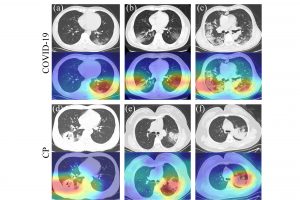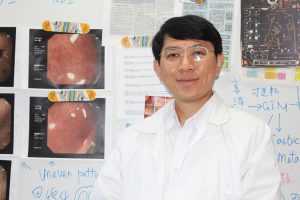Prof Wong Pak Kin in the Faculty of Science and Technology of the University of Macau (UM) and his doctoral student Yan Tao in the Department of Electromechanical Engineering have developed an intelligent system that can successfully distinguish pneumonia caused by the novel coronavirus (COVID-19) from other common types of pneumonia, at a speed that is nearly 60 faster than radiologists, bringing a new feasible solution for pneumonia detection. The study has been published by the international science journal Chaos, Solitons & Fractals.
COVID-19 infection is typically confirmed through reverse-transcription polymerase chain reaction (RT-PCR). However, RT-PCR tests have many problems, such as insufficient supply of the RT-PCR kit, the amount of time required, and a high rate of false negatives. These can impede prompt diagnosis and increase the chances of the spread of the virus. Many experts have proposed using chest computed tomography (CT) to diagnose suspected cases of COVID-19 infection, because CT can detect infection even during the first stage. CT diagnosis has a very high degree of accuracy and can provide more clinical information, but CT images require manual identification of radiographic features. The rapid growth in the number of COVID-19 patients and the necessity for each patient to undergo multiple CT scans (more than 100 slices per scan) have led to a large number of CT images, presenting an enormous challenge for radiologists, especially in areas hit hardest by the pandemic.
In order to address this issue, Prof Wong and Yan Tao worked with researchers at other institutions in Hubei province, namely Wang Jiangtao, deputy director of the Department of Radiology at Xiangyang Central Hospital and Doctor Ren Hao at the same hospital; Li Yang, deputy director of the Department of Radiology at Xiangyang First People’s Hospital; and Wang Huaqiao, a surgeon in the Division of Surgery at the same hospital. They retrospectively collected data on 206 patients with confirmed positive RT-PCR for COVID-19 and their 416 CT scans, as well as data on 412 patients with non-COVID-19 pneumonia and their 412 chest CT scans with clear signs of pneumonia. Based on these CT images, they developed an automatic diagnosis system based on a multi-scale convolutional neural network. The verification results have shown that after being fed a limited amount of data, the intelligent diagnosis system can successfully distinguish COVID-19-caused pneumonia from other common types of pneumonia. Its diagnostic ability is comparable to that of experienced radiologists, but the diagnosis speed is nearly 60 faster. This brings a new feasible solution for pneumonia detection. Prof Wong’s team hopes to expand the functions of the system. They are working to develop a multi-type pneumonia diagnosis algorithm and a new coronavirus pneumonia severity prediction algorithm, which is expected to be completed soon. The intelligent system will be able to distinguish between normal lungs and lungs infected with five common types of pneumonia, thereby predicting the severity of the condition of COVID-19 patients.
The related paper, titled ‘Automatic Distinction between COVID-19 and Common Pneumonia using Multi-Scale Convolutional Neural Network on Chest CT Scans’, has been published by the international science journal Chaos, Solitons & Fractals, a SCI Q-1 journal, only one month after its submission.
For details of the research article, please visit: https://doi.org/10.1016/j.chaos.2020.110153
(PPC/CO/094)
Source: Faculty of Science and Technology
Media Contact Information:Communications Office, University of Macau
Albee Lei Tel:(853) 88228004Judite Lam Tel:(853) 88228022Email:prs.media@um.edu.moUM Website:www.um.edu.mo



